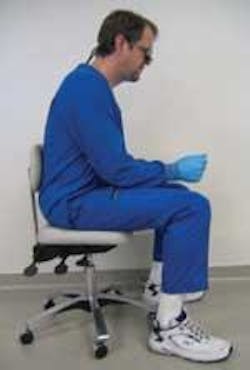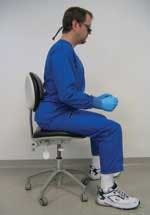All the wrong moves: three movement mistakes that lead to pain
by Bethany Valachi, MS, PT, CEAS
For more on this topic, go to www.dentaleconomics.com and search using the following key words: palms–down reaching, dental operator pivot exercise, preventing pain in dentistry, Bethany Valachi.
Movement in the operatory. It's a good thing, isn't it? Since prolonged, static postures in dentistry cause some of the worst structural damage in our bodies, it makes sense to move as often as possible. However, certain common movement patterns in the operatory can lead to muscle imbalances, joint degeneration, or disc herniation. Following are the three most common movement patterns that can make your body miserable. Over months or years the accumulated microtrauma from these motions can lead to a number of musculoskeletal dysfunctions. Are any of these familiar to you?
1) Leaning forward from the waist
The most common “moving violation” in the operatory is slouching forward from the waist to view the tooth surface. Obviously you are going to need to leave the backrest of your operator stool periodically to view a tooth surface that cannot be viewed in a neutral, balanced position. However, the way you lean forward can make the difference between a strong, healthy back, and a muscle strain or disc herniation.
When you lean forward from the waist (Fig. 1a), you literally hang on your back muscles and ligaments, which can lead to the development of muscle strains or trigger points. The risk is even greater for your spinal discs. In this posture, the nucleus in your spinal disc gets pushed backward and can wear and tear away at the back wall of your disc until the posterior wall becomes so thin and weak it is at risk for herniation. Even scarier is the fact that only the outer one third of your spinal disc has nerves. Therefore, you can wear and tear away two thirds of your disc wall (from the inside out) before you ever have a painful warning sign. By then it is often too late and a bulge or herniation may easily occur.
To avoid these risks, it is imperative that dentists stabilize the low back with their own internal “back belts” whenever they leave the backrest of their operator stools. Your transverse abdominal muscles are the deepest layer of abdominal muscles that wrap horizontally around your midsection. They play a vital role in stabilizing your lumbar spine, and when properly used, have been shown to reduce low back pain in up to 80% of low back pain patients.
To engage your natural back belt, perform this “operator pivot” exercise.
Dental operator pivot exercise
- Sit tall on the stool with a slight curve in the low back.
- Assume an operating position with the arms.
- To activate the transverse abdominal muscle, exhale, and actively (with your muscles) pull your navel toward your spine. A common mistake is to suck in your breath to pull the spine toward the navel. You should still be able to talk, breathe, and move while holding this contraction. An alternate method, which utilizes all three abdominal wall layers, is to “brace” with the abdominal muscles as though preparing to be hit in the stomach.
- Using the hips as a fulcrum, pivot forward from the hips, maintaining the abdominal contraction throughout the exercise. (Fig. 1b)
You can check to make sure you're using the proper muscles by locating the two bony landmarks on the front of each side of your pelvis (referred to as the ASIS in physical therapy). Move your fingers one finger–width above this bony prominence, then exhale and actively pull your navel inward toward your spine. If you are correctly using the transverse abdominal muscles, you will feel a contraction underneath your fingertips.
Try to make this exercise a habit in the operatory whenever you leave the backrest of your operator stool. The more you perform it, the stronger your natural back belt will become!
2) Palms–down reaching
A second common moving error is reaching for the operatory light or delivery system in a palms–down position. This causes excessive compression in the sub–acromial space of the shoulder and can lead to shoulder dysfunction.
Try this simple exercise: While sitting, roll your shoulder slightly forward, as though reaching for the light, and very slowly raise your arm straight forward in a palms–down position. Most people will feel an uncomfortable “clunk” just after the arm passes the horizontal plane. Now rotate your hand to a thumbs–up position. Repeat the test and you will notice there is no clunk at all, and your shoulder joint will glide smoothly into full flexion.
You may notice that some operatory lights have a vertical handle. Was this ergonomic design intended to address biomechanics of the shoulder? It's hard to say, but regardless, this orientation of the handle encourages proper movement of the shoulder.
While this shoulder movement is easily preserved when reaching for handpieces, which are usually positioned vertically on the delivery system, it becomes more challenging when retrieving instruments lying flat on the delivery system.
Strive to reach toward the delivery system (especially if it is positioned to one side of the dentist) with a thumbs–up position, and do not rotate the hand to a palms–down position until the very last moment to retrieve the instrument. This side–reaching pattern is challenging, but with practice can easily become a habit. Palms–down reaching is especially damaging to the shoulder when performed repeatedly to one side (abduction) and even worse when reaching above elbow height.
3) Twisting to retrieve instruments
Studies show that twisting repeatedly toward one side can contribute to low back pain. This movement can be caused by a rear delivery system used in a two–handed operatory, or by dentists who insist on retrieving their own handpieces or instruments and changing their own burs. Ideally, dentists who operate with a rear delivery system should practice true four–handed dentistry, where the assistant is fully utilized to change burs, etc., and provide efficient instrument transfers throughout the procedure.
When operating alone, dentists or hygienists should practice retrieving handpieces and instruments with the nondominant hand and transferring them to the dominant hand. It may take a few extra seconds to make the transfer, but it is very likely that repeated one–way trunk twisting would reduce your number of years in your career.
Movement is generally a good idea in the operatory to counteract damaging microtrauma caused by prolonged, static postures; however, certain movement patterns in the operatory should be avoided and replaced with safer, kinesiologically sound motions that allow your body to move in its most neutral anatomical planes.
Bethany Valachi, PT, MS, CEAS, is a physical therapist, dental ergonomic consultant, and CEO of Posturedontics®, a company that provides research–based dental ergonomic education. She lectures internationally, and is an instructor of ergonomics at OHSU School of Dentistry. Valachi covers the above topics and more in her book, “Practice Dentistry Pain–Free,” available at www.posturedontics.com or by calling (503) 291–5121.



